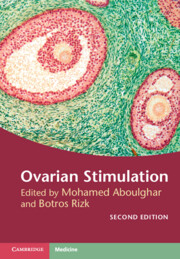Book contents
- Ovarian Stimulation
- Ovarian Stimulation
- Copyright page
- Dedication
- Contents
- Contributors
- About the Editors
- Foreword
- Preface to the first edition
- Preface to the second edition
- Section 1 Mild Forms of Ovarian Stimulation
- Section 2 Ovarian Hyperstimulation for IVF
- Section 3 Difficulties and Complications of Ovarian Stimulation and Implantation
- Section 4 Non-conventional Forms Used during Ovarian Stimulation
- Section 5 Alternatives to Ovarian Hyperstimulation and Delayed Transfer
- Section 6 Procedures before, during, and after Ovarian Stimulation
- Chapter 26 Ultrasound Monitoring for Ovulation Induction: Pitfalls and Problems
- Chapter 27 The Use of GnRH Agonists to Trigger Final Oocyte Maturation during Controlled Ovarian Stimulation
- Chapter 28 The Luteal Phase Support in In Vitro Fertilization
- Chapter 29 Luteal Phase Support Other than Progesterone
- Chapter 30 Ovarian Reserve as a Guide for Ovarian Stimulation
- Index
- References
Chapter 27 - The Use of GnRH Agonists to Trigger Final Oocyte Maturation during Controlled Ovarian Stimulation
from Section 6 - Procedures before, during, and after Ovarian Stimulation
Published online by Cambridge University Press: 14 April 2022
- Ovarian Stimulation
- Ovarian Stimulation
- Copyright page
- Dedication
- Contents
- Contributors
- About the Editors
- Foreword
- Preface to the first edition
- Preface to the second edition
- Section 1 Mild Forms of Ovarian Stimulation
- Section 2 Ovarian Hyperstimulation for IVF
- Section 3 Difficulties and Complications of Ovarian Stimulation and Implantation
- Section 4 Non-conventional Forms Used during Ovarian Stimulation
- Section 5 Alternatives to Ovarian Hyperstimulation and Delayed Transfer
- Section 6 Procedures before, during, and after Ovarian Stimulation
- Chapter 26 Ultrasound Monitoring for Ovulation Induction: Pitfalls and Problems
- Chapter 27 The Use of GnRH Agonists to Trigger Final Oocyte Maturation during Controlled Ovarian Stimulation
- Chapter 28 The Luteal Phase Support in In Vitro Fertilization
- Chapter 29 Luteal Phase Support Other than Progesterone
- Chapter 30 Ovarian Reserve as a Guide for Ovarian Stimulation
- Index
- References
Summary
Gonadotropin-releasing hormone (GnRH) is secreted from the medial basal hypothalamus and controls pituitary function via the hypothalamic tuberoinfundibular system [1]. Follicle-stimulating hormone (FSH) and luteinizing hormone (LH) are synthesized and secreted by the anterior pituitary gland in response to GnRH pulse activity. Physiological modulation of GnRH pulse amplitude and frequency determines the fine interplay between various gonadotropin players during the menstrual cycle [2;3].
- Type
- Chapter
- Information
- Ovarian Stimulation , pp. 282 - 289Publisher: Cambridge University PressPrint publication year: 2022



